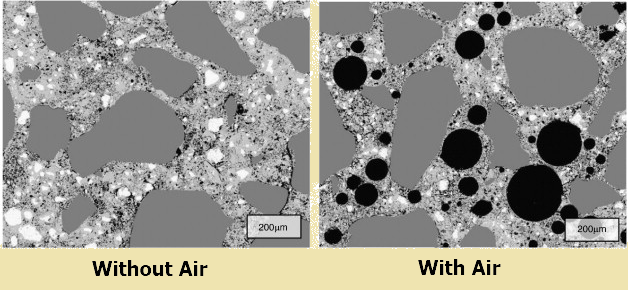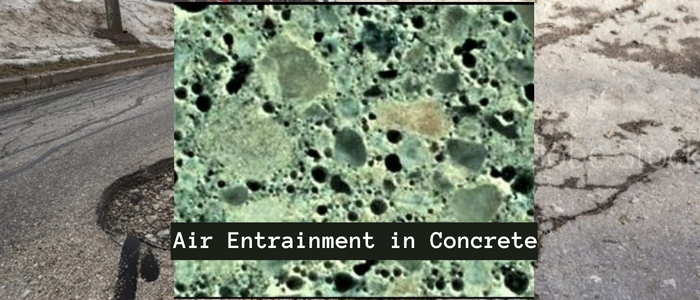Normal concrete consists of cement paste that holds the aggregate particles together. The cement paste itself is made by mixing cement and water. When it comes to air entrainment in concrete, We add an additional material (an admixture) to the previous components to give what we call “Air Entrained Concrete”
What is Air Entrained Concrete?
We can define Air Entrained Concrete as normal concrete but with an additional feature, which is the introduction of controlled amounts of air into concrete in the form of microscopic bubbles. The following image shows how the air bubbles look like under the light microscope.

Also, look at the following microscopic image. It shows the same concrete mixture but one without air and one with air (air bubbles appear as black holes under microscope).

It is important to mention here that air bubbles are added to concrete intentionally! Yes we intend to add them from the beginning.
Description of Air Bubbles in Concrete
There is a number of things we can say regarding the air bubbles that we introduce in concrete.
The first thing that distincts the entrained air in concrete is that these air bubbles are isolated. This means they are different from the typical pores that exist in concrete (capillary pores) which are connected.
So what is the benefit of the air bubbles being isolated and not connected together?
The benefit is that they do not negatively affect the durability of concrete. In order for the detrimental substances get inside concrete, they need pathways to allow them to pass. These pathways are actually the connected pores. Therefore, if the air bubbles that we introduce in concrete are not connected, this means they will not act as pathways, which is pretty good. right?
We entrain air as we want without negatively affecting the durability and integrity of concrete.
The second feature of air bubbles is the variable size. Not all bubbles have the same size, which is of course normal. This is something basically beyond our control but there is an approximate range they may fit into –> a few thousandths of a centimeter in diameter to a few hundredths.
Now our knowledge of air entrainments is getting better but there is a basic question to answer. Who can we generate the air bubbles in concrete?
How Air Bubbles are Generated?
The air bubbles are added to concrete through the incorporation of what we call “air-entraining admixtures“.
The air-entraining admixtures usually come in liquid form. They are added to the mixing water of concrete and vigorously mixed together. You can just type “air entraining admixture” in your search engine and you will find products from multiple companies with different available sizes.
Then, the mixing water including the air entraining admixture is added to the rest of components (Cement and aggregates) as in case of regular concrete.
So, the question here is do we use any random product from any company? The short answer is no.
Choosing a certain air entraining admixture depends on your experience with the products. Did you try a certain product before? Does your company have a record of the performance of certain products? etc
What if you do not have a record or experience with a certain product?
Here comes the role of trial and error.
You pick a certain product based on the data sheet and reputation of a company and do trial batching using the same product to see how it performs and whether it achieves the intended purpose of not?
So, what happens is that you choose a certain value for the percentage of air entrainment in concrete in the design mix and then after you finish the design, you do trial batching to make sure that the amounts you designed for are the ones that you are obtaining. Otherwise, you will need adjustments.
Read on air content testing here
If you would like to read more on the air entrainment in concrete, how they affect concrete and why we add the air intentionally, just follow this link
